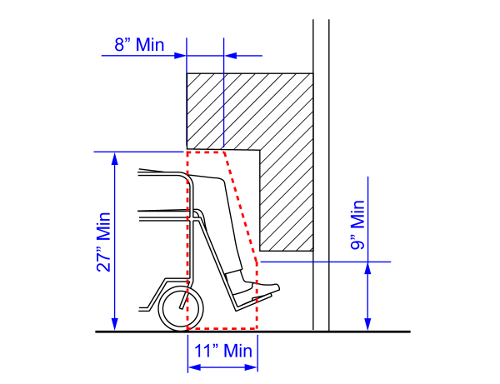Knee clearance is a crucial element of accessible design mandated by the Americans with Disabilities Act (ADA). It addresses the need for individuals who use wheelchairs or other mobility aids to have unimpeded access to fixtures such as sinks and work surfaces. Proper knee clearance not only ensures compliance with legal standards but also promotes dignity, independence, and usability for everyone in a given space.

In practical terms, knee clearance refers to the space required beneath counters, sinks, and similar installations. According to ADA guidelines, the height of sinks should not exceed 34 inches from the floor, which allows individuals in wheelchairs to approach comfortably. Below these sinks, a minimum of 27 inches of vertical clearance is mandated. This dimension is critical because it allows users to roll underneath the sink without obstruction, facilitating tasks such as handwashing, grooming, or food preparation.
Beyond vertical space, the depth of knee clearance is also essential. The learn about ada knee space here specifies that there should be a minimum depth of 11 to 25 inches to accommodate various wheelchair designs. This range ensures that individuals can position themselves adequately while using the sink or countertop, enabling a more functional experience.
Another important consideration is the need for clear space in front of the fixture. The ADA recommends at least 30 inches in width and 48 inches in depth for clear floor space in front of sinks or work surfaces. This ample space allows users to maneuver easily and approach fixtures without encountering barriers, enhancing the overall usability of the environment.
Knee clearance is not just about meeting regulatory requirements; it is about creating environments that foster independence and inclusivity. Proper design helps prevent accidents and allows individuals to engage fully in daily activities. For example, when individuals can access sinks and countertops without obstruction, they can perform essential tasks more easily and confidently.
Incorporating knee clearance into design practices is essential in various settings, including public restrooms, kitchens, and workplaces. By doing so, architects and designers not only comply with ADA standards but also contribute to a more equitable society where everyone can participate fully in everyday life.
In summary, understanding the significance of ADA knee clearance is vital for creating accessible and welcoming spaces. By focusing on the necessary dimensions for vertical and horizontal clearance, designers can enhance usability and safety in a variety of environments. This commitment to accessibility enriches the lives of individuals with disabilities, empowering them to navigate and interact with their surroundings with confidence and ease.